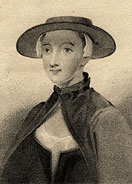Regency Personalities Series-Hester Chapone
Regency Personalities Series
In my attempts to provide us with the details of the Regency, today I continue with one of the many period notables.
Hester Chapone
1727–1801

Hester Chapone
Hester Chapone was the daughter of Thomas Mulso, a gentleman farmer, and his wife, a daughter of Colonel Thomas, Hester wrote a romance at the age of nine, ‘The Loves of Amoret and Melissa’, which earned her mother’s disapproval. She was educated more thoroughly than most girls in that period, learning French, Italian and Latin, and began writing regularly and corresponding with other writers at the age of 18. Her earliest published works were four brief pieces of Samuel Johnson’s journal The Rambler in 1750. She was married in 1760 to the solicitor John Chapone (c.1728–1761), who was the son of an earlier moral writer, Sarah Chapone (1699–1764), but soon widowed. Hester Chapone was associated with the learned ladies or Bluestockings who gathered around Elizabeth Montagu, and was the author of Letters on the Improvement of the Mind and Miscellanies. She died at Hadley, Middlesex, on 25 December 1801.
The former was first written for her 15-year-old niece, in 1773, but by 1800 it had been through at least 16 editions. A further 12 editions appeared until 1829, at least one of them a French translation. They focused on encouraging rational understanding through the reading of the Bible, history and literature. The girl was also supposed to study book-keeping, household management and botany, geology, astronomy. Only sentimental novels were to be avoided. Mary Wollstonecraft singled it out as one of the few examples of the self-improvement genre deserving of praise.
This tide of advice or conduct books reached its height between 1760 and 1820 in Britain; one scholar refers to the period as “the age of courtesy books for women”. Chapone’s is a typical example.
Conduct books integrated the styles and rhetorics of earlier genres, such as devotional writings, marriage manuals, recipe books, and works on household economy. They offered their readers a description of (most often) the ideal woman while at the same time handing out practical advice. Thus, not only did they dictate morality, but they also guided readers’ choice of dress and outlined “proper” etiquette. Chapone’s work, in particular, appealed to Wollstonecraft at this time and influenced her composition of Thoughts because it argued “for a sustained programme of study for women” and was based on the idea that Christianity should be “the chief instructor of our rational faculties”. Moreover, it emphasised that women should be considered rational beings and not left to wallow in sensualism. When Wollstonecraft wrote A Vindication of the Rights of Woman in 1792, she drew on both Chapone and Macaulay’s works. Another admirer, and also a personal friend, was the novelist and diarist Frances Burney. Their surviving correspondence includes a letter of condolence of 4 April 1799, from Burney to Chapone, on the death in childbirth of Jane Jeffreyes, née Mulso, the niece to whom the Letters on the Improvement of the Mind had been addressed.
Elizabeth Gaskell, the nineteenth century novelist, refers to Chapone as an epistolatory model, bracketing her in Cranford with Elizabeth Carter, a much better educated Bluestocking.
The book is also mentioned in Anne Brontë’s novel Agnes Grey through the character Miss Wooler. It also had an influence in Samuel Richardson, Jane Austen and Mary Wollstonecraft.
Elizabeth Carter edited a posthumous compilation of Chapone’s writings, entitled “The Posthumous Works of Mrs. Chapone: Containing Her Correspondence with Mr. Richardson; a Series of Letters to Mrs. Elizabeth Carter, and Some Fugitive Pieces, Never Before Published. Together with an Account of Her Life and Character, Drawn Up by Her Own Family” (1807). There, Chapone is quoted:
“Though men’s ways are unequal, the ways of God are equal, and with him even women shall find justice.”




